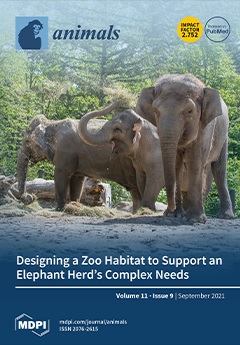View Item
- xmlui.general.dspace_homeCentros e Institutos de InvestigaciónCIAP. Centro de Investigaciones AgropecuariasInstituto de Investigación Animal del Chaco SemiáridoArtículos científicosxmlui.ArtifactBrowser.ItemViewer.trail
- DSpace Home
- Centros e Institutos de Investigación
- CIAP. Centro de Investigaciones Agropecuarias
- Instituto de Investigación Animal del Chaco Semiárido
- Artículos científicos
- View Item
Assessment of Influential Factors for Scours Associated with Cryptosporidium sp., Rotavirus and Coronavirus in Calves from Argentinean Dairy Farms
Abstract
Scours is the most common disease in dairy calves, and it is a multifactorial syndrome complex. Cryptosporidium sp. (C. sp.), rotavirus group A (RVA), and bovine coronavirus (BCoV) are the three main pathogens associated with scours. The objective of this study was to identify potential factors associated with scours, C. sp., RVA, and BCoV infections in preweaned dairy calves from Lerma Valley in Salta Province, Argentina. A total of 488 preweaned calves
[ver mas...]
Scours is the most common disease in dairy calves, and it is a multifactorial syndrome complex. Cryptosporidium sp. (C. sp.), rotavirus group A (RVA), and bovine coronavirus (BCoV) are the three main pathogens associated with scours. The objective of this study was to identify potential factors associated with scours, C. sp., RVA, and BCoV infections in preweaned dairy calves from Lerma Valley in Salta Province, Argentina. A total of 488 preweaned calves from 19 dairy farms located in the Lerma Valley were enrolled in this observational study. One fecal sample was collected from each calf between one week and two months of age for assessment of C. sp., RVA, and BCoV infection status. Cryptosporidium sp. oocysts and RVA and BCoV antigens in fecal samples were assessed using microscopic observation and indirect enzyme-linked immune sorbent assay (iELISA), respectively. A voluntary questionnaire was developed and used to collect data regarding management practices from the participants’ farms. The data were analyzed using multivariable logistic regression models. Scours incidence was 35.4%, and a greater proportion of calves younger than 20 days were affected. Of the fecal samples, 18% and 9.5% tested were positives for C. sp. and RVA, respectively, while BCoV was detected only in two calves. Furthermore, 84.2% and 63.1% of the farms tested positive for Cryptosporidium sp. and RVA, respectively. In addition, the following variables were associated with higher odds of having scours: (1) herd size (>300 milking cows; OR = 1.7), (2) calf age (<20 days of age; OR = 2.2), (3) RVA and C. sp. test (positive test; RVA OR = 2.6; C. sp. OR = 3), calf feeding practices (feeding milk replacer; OR = 1.81), and newborn calf management practices (calf moved from maternity pen <6 h after calving; OR = 1.7). Concerning RVA infection, calves less than 20 days of age (OR = 2.6) had a higher chance of testing positive for RVA, while calves that remained in the calving pen for less than 6 h after calving had a lower chance (OR = 0.3). On the other hand, for C. sp. infection, large farm size (>300 milking cows; OR = 1.2) and young calf age (<20 days of age; OR = 4.4) indicated a higher chance of testing positive for C. sp., while calves belonging to farms that fed frozen colostrum (OR = 0.2) had a lower chance of becoming infected with C. sp. The result of this study indicated that scours is a prevalent disease in farms of the Lerma Valley, Salta, Argentina, and that RVA and C. sp. infections, along with specific farm management practices, might be important contributing factors that could increase the chance of NCS in dairy farms.
[Cerrar]

Author
Bertoni, Emiliano Agustín;
Barragán, Adrián A.;
Bok, Marina;
Vega, Celina Guadalupe;
Martinez, Gabriela Marcela;
Gil, José F.;
Cimino, Rubén Oscar;
Parreño, Gladys;
Fuente
Animals 11 (9) : 2652. (2021)
Date
2021-09
Editorial
MDPI
ISSN
2076-2615
Formato
pdf
Tipo de documento
artículo
Palabras Claves
Derechos de acceso
Abierto
 Excepto donde se diga explicitamente, este item se publica bajo la siguiente descripción: Creative Commons Attribution-NonCommercial-ShareAlike 2.5 Unported (CC BY-NC-SA 2.5)
Excepto donde se diga explicitamente, este item se publica bajo la siguiente descripción: Creative Commons Attribution-NonCommercial-ShareAlike 2.5 Unported (CC BY-NC-SA 2.5)


